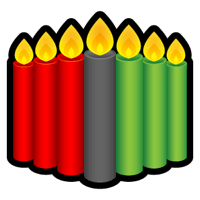Kwanzaa is a seven day festival that celebrates African and African American culture and history. Kwanzaa takes place from 26th December to 1st January.
The
name Kwanzaa comes from the phrase 'matunda ya kwanza' which means
'first fruits' in the Swahili language (an Eastern African language
spoken in countries including Kenya, Uganda, Tanzania, Mozambique and
Zimbabwe). Kwanzaa is mostly celebrated in the USA.
 During
Kwanzaa a special candle holder called a kinara is used. A kinara
hold seven candles, three red ones on the left, three green ones on
the right with a black candle in the centre. Each night during
Kwanzaa a candle is lit. The black, centre, candle is lit first and
the it alternates between the red and green candles stating with the
ones on the outside and moving inwards. This is quite similar to the
lighting of the menorah in the Jewish Festival of Lights, Hanukkah.
During
Kwanzaa a special candle holder called a kinara is used. A kinara
hold seven candles, three red ones on the left, three green ones on
the right with a black candle in the centre. Each night during
Kwanzaa a candle is lit. The black, centre, candle is lit first and
the it alternates between the red and green candles stating with the
ones on the outside and moving inwards. This is quite similar to the
lighting of the menorah in the Jewish Festival of Lights, Hanukkah.
The
seven days and candles in Kwanzaa represent the seven principles of
Kwannzaa (Nguzo Saba):
- Umoja: Unity - Unity of the family, community, nation and raceKujichagulia: Self-Determination - Being responsible for your own conduct and behaviour
- Ujima: Collective work and responsibility - Working to Help each other and in the community
- Ujamaa: Cooperative economics - Working to build shops and businesses
- Nia: Purpose - Remembering and restoring African and African American cultures, customs and history
- Kuumba: Creativity - Using creating and your imagination to make communities better
- Imani: Faith - Believing in people, families, leaders, teachers and the righteousness of the African American struggle
There
are also seven symbols used in Kwanzaa. The seven items of often set
on a Zwanzaa table, with the kinara, in the house:
- Mkeka: The Mat - A woven mat made of fabric, raffia, or paper. The other symbols are placed on the Mkeka. It symbolises experiences and foundations.
- Kikombe cha Umoja: The Unity Cup - Represents family and community. It is filled with water, fruit juice or wine. A little is poured out to remember the ancestors. The cup is share between people and each person takes a sip.
- Mazao: The Crops - Fruit and vegetables from the harvest. These normally includes bananas, mangoes, peaches, plantains, oranges, or other favourites! They are shared out.
- Kinara: The Candleholder - It represents the days, and principles of Kwanzaa
- Mishumaa Saba: The Seven Candles - are placed in the kinara. Black, red and green are the colours of the Bendera (African Flag)
- Muhindi: The Corn - There is one ear of corn of each child in the family. If there are no children in the family, then one ear is used to represent the children in the community. It represents the future and the Native Americans.
- Zawadi: Gifts - Gifts given to children during Kwanzaa are normally educational, such as a book, dvd or game. There's also a gift reminding them of their African heritage.
There
are also sometimes two extra symbols:
- Bendera: A flag with three horizontal stripes of black, red and green
- Nguzo Saba Poster: A poster of the seven principles of Kwanzaa
There's
also a special greeting used during Kwanzaa in Swahili. It's 'Habari
gani' and the reply is the principle for that day. (Umoja on the
first day, Kujichagulia on the second and so on.)
The
Kwanzaa festival was created by Dr. Maulana Karenga in 1966. Dr.
Karenga wanted a way bring African Americans together and remember
their black culture. Harvest or 'first fruit' festivals are
celebrated all over Africa. These were celebrations when people would
come together and celebrate and give thanks for the good things in
their lives and communities.
From
these festivals he created Kwanzaa.




Another interesting festival.
ReplyDeleteYes I thought so never ever heard of this before it is interesting what other people do around this time of year
DeleteI was aware of Kwanzaa but not all that it represented. It was cool finding out about it and it's origins. Thank you for that. 🎉
ReplyDeleteYou are welcome
DeleteDearest Jo-Anne,
ReplyDeleteNever heard any mention of it here in the USA during the 31 years we've been living here!
Did some research and found this writer's story about: maybe not everyone is fooled by a faux holiday created by a criminal? http://wizbangblog.com/2014/12/16/the-kwanzaa-scam-a-fake-holiday-created-by-a-racist-rapist-and-torturer/
So that's about it! Not for me...
Sending you hugs for the final day of the year and wishing you a happy New Year's Eve!
Mariette
Never came across that information while doing the research so my bad.................thank you for sharing it with me now I know a little more
Delete